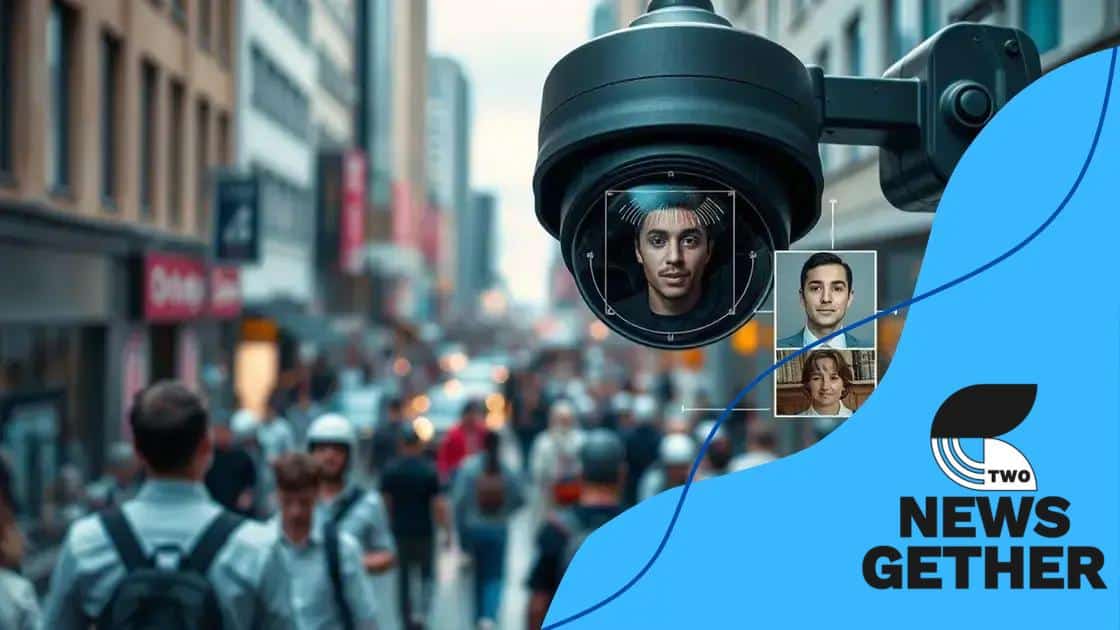The role of facial recognition in enhancing public safety

The role of facial recognition in enhancing public safety includes improving crime prevention, identifying suspects in real-time, and monitoring large events, while raising important privacy concerns.
The role of facial recognition in enhancing public safety is becoming increasingly significant. Have you considered how this technology impacts our daily lives and the safety of our communities?
Understanding facial recognition technology
Understanding facial recognition technology is essential for grasping its role in enhancing public safety. This innovative technology allows systems to identify and verify individuals by analyzing facial features from images. As it becomes more prevalent, it’s crucial to understand how it operates and its implications.
How It Works
Facial recognition technology works by using algorithms to measure and compare unique facial characteristics. Here’s a simple breakdown:
- Detection: The system identifies a face within an image.
- Recognition: It analyzes facial structures, such as the distance between the eyes.
- Matching: The system compares the measured facial features against a database.
This process happens in a matter of seconds, making it efficient for security applications. It can be used in various environments, from airports to public events, where safety is a top priority.
Types of Facial Recognition
There are different types of facial recognition technologies. Some can be used in real-time, while others work with images captured previously. Each has its own applications:
- Live facial recognition: Analyzing live video feeds.
- Static facial recognition: Working with stored images.
- 3D facial recognition: Using depth information for higher accuracy.
These types help to enhance security by enabling quick identification and response to potential threats. This technology is particularly useful in crowded settings where monitoring is challenging.
As many people may worry about privacy, it’s essential to balance the advantages of this technology with ethical considerations. Understanding the mechanics behind facial recognition helps inform discussions about its implementation and regulation.
How facial recognition enhances security
How facial recognition enhances security is a crucial topic in today’s world. By utilizing advanced technologies, this system can significantly improve safety in various environments.
Benefits of Facial Recognition in Security
Facial recognition technology offers numerous benefits that strengthen overall security measures. Here are some key advantages:
- Immediate identification of suspects during crowds.
- Automated monitoring of public spaces.
- Enhanced surveillance capabilities for law enforcement.
This technology allows authorities to respond quickly to potential threats. With real-time analysis, it can aid in preventing crimes before they happen.
Case Studies of Successful Implementation
Many cities around the world have integrated facial recognition into their security strategies. For example, airports use this technology to streamline passenger verification, improving efficiency and safety.
Another example is large public events where security personnel rely on facial recognition to monitor attendees. This helps in identifying individuals with outstanding warrants or previous offenses quickly.
Additionally, businesses are using facial recognition for access control, allowing only authorized personnel into secure areas. This not only protects sensitive information but also reduces theft and unauthorized access.
Despite its benefits, some people raise concerns about privacy and misuse. Balancing technology’s advantages with respect for individual rights is vital in discussions about its future use.
Privacy concerns surrounding facial recognition

Privacy concerns surrounding facial recognition have become increasingly prominent as the technology evolves. Many people worry about how their personal information is collected, stored, and used.
Data Collection and Usage
Facial recognition systems gather data by capturing images of individuals without explicit consent. This raises several issues:
- How long is the data kept?
- Who has access to it?
- Are individuals informed about its use?
These questions highlight the need for transparent policies regarding data management.
Potential for Misuse
Another concern is the potential misuse of facial recognition technology. For example, it could be used for mass surveillance, infringing on individuals’ rights. Governments or organizations might track individuals without their knowledge.
This kind of oversight could lead to discrimination and escalation in surveillance, which many view as a violation of personal freedoms. Trust in technology decreases when individuals feel they are constantly monitored.
Additionally, wrongful identification can have serious consequences. Errors in the facial recognition system may lead to false accusations or unjust detainment, affecting innocent people.
To address these challenges, ongoing discussions about regulations and ethical use of facial recognition technology are essential. Striking a balance between security and privacy is crucial for the responsible deployment of this technology.
Real-world applications in public safety
Real-world applications in public safety showcase how facial recognition technology is actively contributing to safer communities. From crime prevention to emergency response, its impact is significant.
Crime Prevention and Law Enforcement
Law enforcement agencies worldwide utilize facial recognition to enhance public safety. By identifying suspects in real time, they can respond faster to incidents. Here are some key applications:
- Matching faces from surveillance cameras against databases of known criminals.
- Identifying missing persons or individuals in distress.
- Tracking down repeat offenders in crowded events.
This technology aids police in making informed decisions and deploying resources more effectively during critical situations.
Monitoring Large Events
Facial recognition is particularly valuable at large public gatherings, such as concerts or sports events. It helps manage security by:
- Screening attendees at entry points to enhance security checks.
- Quickly identifying individuals with outstanding warrants or prior offenses.
- Allowing security personnel to monitor crowds in real-time for potential threats.
Using facial recognition during these events not only improves safety but also provides peace of mind for attendees.
Additionally, the technology plays a vital role in emergency response situations. In events like natural disasters, facial recognition can help identify and locate individuals who may need assistance. This capability is crucial in efficiently allocating resources during crises.
As technology continues to advance, the potential for facial recognition in public safety applications will likely grow, offering new opportunities for enhancing community safety initiatives.
Future developments in facial recognition
Future developments in facial recognition hold exciting prospects as advancements in technology continue to unfold. As we look ahead, several trends and innovations stand out.
Improved Accuracy and Speed
One key area for future development is enhancing the accuracy and speed of facial recognition systems. New algorithms are being designed to:
- Minimize errors in identifying individuals.
- Recognize faces in various lighting and environmental conditions.
- Process images faster to provide real-time results.
These improvements will make the technology more reliable, expanding its use in everyday settings.
Integration with Other Technologies
Another promising direction involves integrating facial recognition with other technologies, such as artificial intelligence (AI) and big data analytics. This can help in:
- Analyzing behavioral patterns to predict potential threats.
- Enhancing security systems by linking multiple data sources.
- Creating personalized experiences in sectors like retail and hospitality.
This integration brings together data-driven insights and facial recognition, forging a more comprehensive approach to safety and user engagement.
Moreover, advancements in privacy features are emerging to address public concerns. Future facial recognition systems may incorporate stronger encryption and anonymization techniques to protect personal data, ensuring compliance with evolving regulations.
The collaboration between law enforcement, technology developers, and policymakers will be crucial in shaping the future of facial recognition. By fostering responsible use of this technology, stakeholders can ensure that it serves public safety while respecting individual rights.
FAQ – Frequently Asked Questions about Facial Recognition in Public Safety
How does facial recognition technology enhance public safety?
Facial recognition technology enhances public safety by providing real-time identification of individuals, improving crime prevention and emergency responses.
What are the privacy concerns associated with facial recognition?
Privacy concerns include unauthorized data collection and the potential for misuse, leading to surveillance and rights violations.
What future developments can we expect in facial recognition technology?
Future developments may include improved accuracy, integration with AI, and stronger data privacy protections.
How is facial recognition used in large public events?
It is used to identify individuals quickly, manage security, and ensure a safer environment for attendees.






